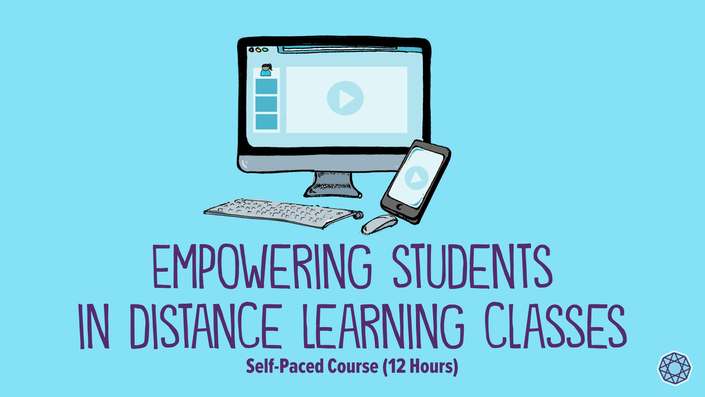
Empowering Students in Distance Learning Classes
Educator Expertise: Any level
Description: What does it mean to empower our students in distance learning environments? How do we help them become self-directed when they are away from their classroom? We tackle these hard questions as we focus on what it means to have students self-select scaffolds, use choice menus, engage in creative projects and self-assess. Each day, you will watch a practical video with specific strategies and then create something meaningful that you will actually use in your distance learning classroom.
How It Works: This course is designed to run about 60 minutes each day for ten days. There is an additional five hours of work that is done independently. However, the course is on-demand and all deadlines are flexible. Every video and resource will be available even after you have finished this course.
Overview:
- Day 1 - Overview of Distance Learning: This first lesson explores the changing role of the teacher, the policies you need to consider (COPPA, CIPA, FERPA), how you'll share expectations with students, communicating with families. You'll also begin a plan for what tools you'll be using.
- Day 2 - Reducing Barriers: You'll design scaffolds for differentiation and explore how to find tutorials for technology. The goal is to empower students to be self-directed when they face challenges. In the end you will create a scaffold for students and a list of tech tutorials they might need to access.
- Day 3 - Boosting Engagement: In this session, we'll focus on how to boost engagement in virtual spaces (such as video conferencing) and how you can create community even when you are far apart. But engagement doesn't have to end when the video conference is over. We'll also explore ways to get students off-screen and moving throughout the day. In the end, you'll create an outline for a video conference you can use with your students.
- Day 4 - Choice and Flexibility in Online Assignments: A simple choice menu is often one of the best ways to introduce student voice and choice in a structured way. In this lesson, we go step-by-step into three different variations of online choice menus that you might use with your students. In the end, you'll create and share a choice menu of your own. In the end, you'll design a short choice menu that your students can use.
- Day 5 - Empowering Student Creativity: At some point, distance learning should include creative work. In this lesson, we explore how to design a structured creative activity that students can do alone, in pairs, or in small groups. In the end, you'll create a design sprint you can use in your classroom.
- Day 6 - Empowering Student Collaboration: Distance learning doesn't have to mean working alone. In this lesson, we explore ways to use communication tools (synchronous and asynchronous) and co-creation tools to boost student collaboration. We'll also dive into specific protocols you can use to improve interdpendency in student collaboration. In the end, you'll create a single collaborative protocol you can use in an distance classroom.
- Day 7 - Empowering Students to Own the Assessment Process: In order to improve, students need meaningful feedback. They need to set goals and reflect on their progress. For this reason, it's important that we craft self-assessments and peer assessments that can boost metacognition and help students determine where they are and what they will do next. In the end, you'll create a student self-assessment form that you can use in your class.
- Day 8 - Tapping into Student Interests: When students own the learning, they get an opportunity to pursue their own interests and passions. In this lesson, we explore what this looks like in various subject areas and grade levels. You'll then create a short video explaining for your students what their passion project might look like.
- Day 9 - Tapping into Student Curiosity: Student ownership includes the opportunity to ask tons of questions and then find the answers on your own. In this lesson, we look at a structured way to do inquiry-based learning at a distance. You'll then create an exemplar you can share with your classroom.
- Day 10 - Designing Systems: Now that you have ideas for how to make it work, you will create an overall plan for your distance learning unit. You'll also explore principles of UX design to create a virtual and online experience that will be clear and intuitive for students. Here's where you get to take a few of the things you've created and put them into a cohesive unit plan. You might not use every single idea -- and that's okay. The goal is to incorporate a few big ideas from this course into your own classroom.
About Your Teacher

John is a former middle school teacher and current professor of educational technology. John creates books, podcasts, articles, and resources designed to empower teachers to transform their classrooms into bastions of creativity and wonder. He is an expert on project-based learning, design thinking, and empowering students with voice and choice.
Course Overview: Videos, Lessons, and Resources
-
StartDay 1: Overview of Distance Learning: (26:19)
-
StartDay 2: Reducing Barriers / Ensuring Access for All Students (16:30)
-
StartDay 3: Boosting Engagement in Virtual Meetings (31:07)
-
StartDay 4: Choice and Flexibility in Online Assignments (13:47)
-
StartDay 5: Empowering Student Creativity (22:13)
-
StartDay 6: Empowering Students in Collaborative Work (16:10)
-
StartDay 7: Empowering Students to Own the Assessment Process (22:37)
-
StartDay 8: Tapping into Student Interests (20:20)
-
StartDay 9: Tapping into Student Curiosity (24:03)
-
StartDay 10: Designing Systems for Student Success (9:12)
-
StartConclusion: Turning in Assignments and Getting the Certificate
Frequently Asked Questions
District and School Bulk Licenses
Please fill out the form below for information on district, school, or consortium bulk licenses. I'll email you back with information to help customize a plan for your organization.
